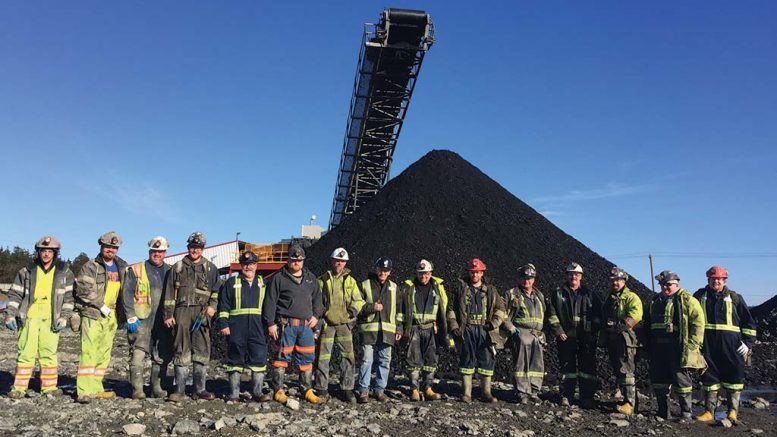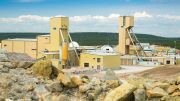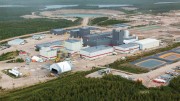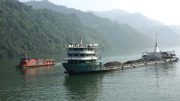Underground coal mining in Cape Breton has resumed after a 15-year hiatus.
The Donkin mine started producing coal at the end of February and the underground operation should churn out 2.75 million saleable tonnes of coal a year over the next three to four years.
With a resource of 481 million tonnes — 227 million tonnes in the indicated category and another 254 million tonnes in the inferred — the Donkin deposit has enough low ash, high-energy coking and thermal coal to last for 25 years or more.
Dawson Brisco, vice-president of corporate development for Morien Resources (TSXV: MOX), which has a royalty on coal production from the mine, says much of the product will be sold to Asian markets, but some of it could find a home in Atlantic Canada for power generation.
“There are two power plants, one 30 km away and another 60 km away, so it’s conceivable that part of it will go as thermal to one of those two plants,” Brisco says, adding that “because it’s a swing product, it can go either metallurgical or thermal.”
No offtake agreement has been signed yet with Nova Scotia Power, Brisco adds, but in the middle of last year, a spokesman for the utility, Beverley Ware, “said they had ‘tested lab quantities and are looking forward to testing larger quantities as the mine production starts up,’ so I suspect that testing is likely happening now, if not soon.”
The bottom line is that Donkin’s coal is good quality, he says. On the thermal side, it’s ultra-low ash, very high-energy coal, with BTUs that run up to 14,000. On the met side, it’s a high-vitrinite, high-fluidity and high-crucible swell number product. “All these attributes make it a sellable coal, either into the domestic market as thermal, or to the export market as a combination of thermal and met,” he says.
Kameron Collieries ULC, which is affiliated with U.S. coal producer Cline Group, bought a 75% interest in Donkin from Glencore (LON: GLEN) in December 2014. Glencore said it was selling its share in the project due to a change in its business strategy with a greater focus on larger volume mining complexes.
Morien sold its 25% working interest in Donkin to Kameron Collieries the same month for $5.5 million in cash in milestone payments and a scaled production royalty. The royalty is 2% on volumes less than 2 million tonnes and 4% on anything above 2 million tonnes, and the company anticipates annual royalties of between $4 million and $8 million.
Kameron has already paid Morien the first two installments of the $5.5 million in milestone payments, and Morien expects to receive the third and final payment within the next 12 months.

Kameron Collieries’ Donkin coal mine in Cape Breton, Nova Scotia. Credit: Kameron Collieries
“We’re waiting for the royalty meter to turn on at Donkin and expect to start receiving cash in the form of the final milestone payment, but also in the form of royalty monies,” Brisco says. “And once that cash flow comes in it will top up our treasury and let us contemplate a dividend, but also get more aggressive with project acquisitions.”
Brisco adds that he thinks the coal environment will improve and that there is room for select development of high-quality projects in the Atlantic basin, due to steady demand from buyers in Europe and Asia.
Thermal coal is trading at US$75 per tonne. Two years ago, around the time Kameron took ownership of Donkin, thermal coal was trading at US$45 per tonne, based on API-2 pricing, which is the index for European-traded thermal coal coming out of the Atlantic basin. (There are several thermal coal indexes around the world providing quotes for coal based on origin, quality and destination.)
“I don’t have an outlook on thermal coal pricing, but we probably won’t see the lows we saw two years ago, and I do expect Donkin’s cash costs will be in the lower quartile, so it should be able to stay profitable in any coal-pricing environment,” Brisco says.
When Glencore completed a feasibility study on Donkin in 2011, he notes, the company estimated Donkin’s operating costs would come in at less than US$60 per tonne.
“I suspect Kameron will produce coal for less than Glencore (Xstrata) predicted. Part of the reason Kameron bought this project is because it’s so low cost, and that fits with their profile in Illinois where Chris Cline, the owner of Kameron, has produced coal profitably for US$20 to US$30 a ton for decades.”
Shannon Campbell, Kameron’s general manager at Donkin, says the coal is between 11 and 12 feet thick, which lends itself to having quite a productive working face, and the mine has two declines that start from the shore and progress down under the ocean. “The tunnels are in the order of 3.8 km long, and when we intersect the coal seam we’ve got a vertical cover of 200 metres between the workings and the ocean floor,” he says in a telephone interview from Sydney, Nova Scotia.
Campbell notes that when Donkin coal competes with coal produced out of Pittsburgh and West Virginia, its proximity to port gives it advantages in terms of shipping costs.
“It’s pretty high-quality coal,” he adds. “If I was going to buy coal to put into a thermal coal process I’d want as much thermal capacity per unit mass as I could get, and Donkin coal certainly has a high calorific value, relatively speaking.”
The company is building a coal-washing plant that should be finished and commissioned at the end of July or early August.
Morien has $3.5 million in working capital and CEO Budreski emphasizes that the company is different from other juniors.
“We’re unique,” he says. “Most junior mining companies are spending all their cash and issuing shares, and we’re buying back stock because we have surplus cash to our needs. We can see ourselves selectively adding assets.”
Morien has bought 6.9 million of its own shares since the first quarter of 2015.
The company’s focus is on royalties in the industrial mineral, bulk commodity, specialty metal and oil-gas sectors. While it is flexible and open to opportunities, Budreski says, Morien is not willing to look in the precious metals space, as Budreski argues it is too competitive.
The company is trading at 55¢ per share within a 52-week range of 27¢ to 74¢ per share. It has 53 million shares outstanding.






congratulations, and welcome to nova scotia. wish you much sucess, nova scotia has a large mining history of industrial minerals, and precious minerals. i have been prospecting and selling and promoting properties for over thirty years. sincerly scott grant